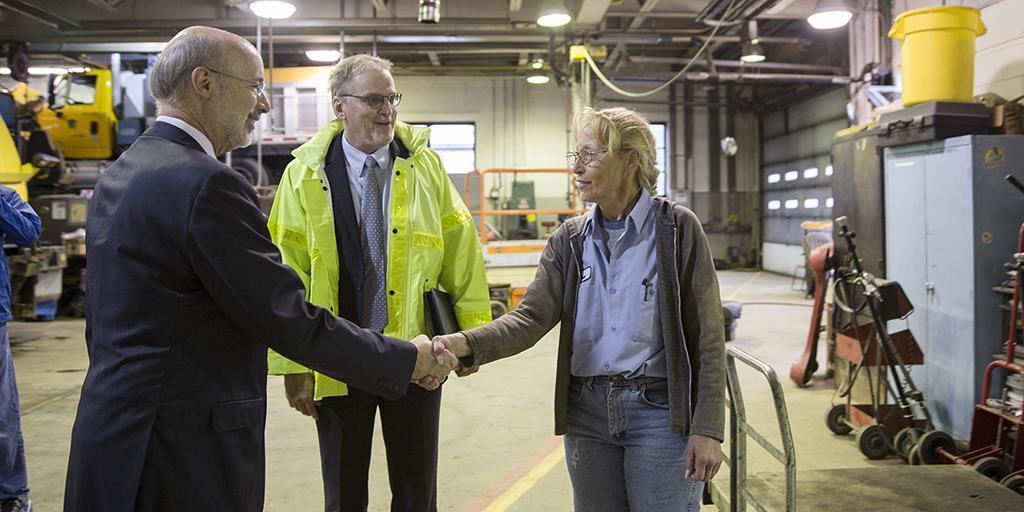
Governor Tom Wolf was in Crawford County recently to remind Pennsylvanians that roadway improvements will be coming to both rural and urban communities throughout the state. In fact, more than 90 projects worth approximately $210 million will be under construction in PennDOT's six-county northwestern region.
Of the two highest-dollar-value projects that are underway in the northwest region, one is located in the region's busiest urban center, while the other is located in the district's most rural county. Those are the $20.9 million project that will improve Interchange Road/Zimmerly Road in metropolitan Erie, and the $24 million Hunter Station Bridge replacement on Route 62 in Forest County.
Along with Hunter Station, major bridge projects include an $11.3 million project to rehabilitate the twin 3,600-foot-long Interstate 79 bridges over the Conneaut Swamp in Crawford County, the $9 million Smock Bridge rehabilitation project on Routes 322/6/19 in the Meadville area, and construction of two 115-foot-long bridges that will span railroad tracks to improve safety on Millfair Road in Erie County.
"We're making investments in every corner of Pennsylvania to improve safety and mobility," Governor Wolf said. "The significant and innovative work happening in this region will pay dividends for the motorists and businesses who use the transportation system."
Recycled Asphalt Pavement
Governor Wolf also discussed regional Recycled Asphalt Paving (RAP) operations that are being expanded elsewhere in the state as part of PennDOT's Road Maintenance and Preservation (Road MaP) initiative.
District 1 maintenance employees plan to pave almost 50 miles of lower traffic roads in the region with RAP this year, and use recycled asphalt to pave the shoulders of more than seven more miles of road. RAP is an environmentally conscious method (PDF) that repurposes materials from projects onto other roadways by mixing ground millings with oil. The district estimates that the per-ton cost of RAP is roughly half the cost of new asphalt material. About $24.1 million in savings (PDF) have been redirected to other projects from the district's RAP program since 2007.
In Governor Wolf's February Road MaP announcement, he noted that RAP will be an increased focus with PennDOT forces starting this year. Armstrong and Monroe counties will see RAP operations this year, with usage expanded in 2018.
ACT 89
The Road MaP program is an extension of Act 89 , Pennsylvania's transportation funding plan, which became law in 2013.
"Thanks to the Act 89 transportation plan, we have been able to make significant progress in addressing structurally deficient bridges in the northwest region," said William G. Petit, district executive of PennDOT District 1.
Currently 173 of the district's 2,069 state-owned bridges — 8.36 percent — are classed as structurally deficient.
Petit added that the additional resources of Act 89 have enabled the district to not only pave more roads, but to undertake much-needed betterment projects that involve more extensive restoration and reconstruction work. Those include projects such as West Road in Erie County, Baldwin Street in Meadville, Route 322 in Venango County, and Route 426 in Warren County.
A map showing all contracted work (PDF) that District 1 has underway or that will start or be bid this year is available on the district's section of PennDOT.gov.
For more information on projects occurring or being bid this year, those made possible by or accelerated by the state transportation funding plan (Act 89), or those on the department's Four and Twelve Year Plans, visit www.projects.penndot.gov.
As construction is underway, PennDOT recommends motorists use 511PA.com to track road conditions at any time. 511PA, which is free and available 24 hours a day, provides traffic delay warnings, weather forecasts, traffic speed information and access to more than 825 traffic cameras.
Follow PennDOT's Northeast regional Twitter account for alerts and updates — or follow our statewide Facebook and Instagram accounts.
ABOUT THIS BLOG
Did you know PennDOT is directly responsible for nearly 40,000 miles of highway and roughly 25,000 bridges? We oversee programs and policies affecting highways, urban and rural public transportation, airports, railroads, ports and waterways, in addition to administering the state's more than 11 million vehicle registrations and 8.8 million driver's licenses.
So, how do we do what we do? And how can we help you travel in Pennsylvania — whether it be for business or leisure — in safe and enjoyable manner? Read PennDOT Way to learn more about the department, what we do, and how and why we do it.
TAGS
50-Year Anniversary, 511PA, Aggressive Driving, Airports, Autonomous Vehicles, Bicycles, Bridges, Child Safety, Community Relations, Construction, COVID-19, Distracted Driving, District 1, District 10, District 11, District 12, District 2, District 3, District 4, District 5, District 6, District 8, District 9, DOTcom, Driver and Vehicle Services, Emergency Responders, Employment, Equity, FAQ Friday, Human Trafficking, Impaired Driving, Innovations, Live Free Ride Alive, Maintenance Monday, Motorcycles, Older Drivers, PA Motorcycle Safety Program, Pedestrians, PennDOT Connects, Ports, Public Transit, Railroads, REAL ID, Road MaP, Roadside Beautification, Rural Roads, Safety, School Buses, Seat Belts, State Transportation Innovation Council (STIC), Sustainability, Teen Drivers, Throwback Thursday, Transportation Funding, Travel in PA, Welcome Centers, Winter, Work Smart, Work Zone, Yellow Dot
LATEST POSTS
PennDOT Continues Sharing, Updating Resources for Local Governments to Pursue Bipartisan Infrastructure Law Funding Opportunities
Norwin High School Wins 2024 ‘Innovations Challenge’
Demo Complete: I-95 CAP Project in Center City Philadelphia
PennDOT Archeologist Connects Past, Present, and Future
Lehigh Valley DUI, Highway Safety Task Force Hosts Law Enforcement Seminar
ARCHIVES
2024
2023
2022
2021
2020
2019
2018
2017

